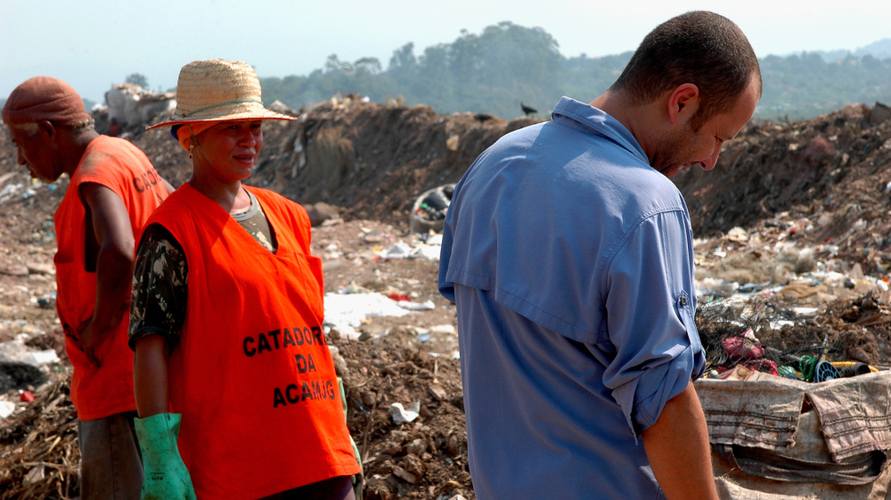
“The moment when something is transformed into something else is the most beautiful moment; it’s a magical moment,” said Brazilian artist Vik Muniz in the 2010 Oscar-nominated documentary Waste Land (in Portuguese, “Lixo Extraordinário”), directed by Lucy Walker, João Jardim and
The movie tells the remarkable story of how the “catadores,” scavengers of recyclable materials found in an enormous landfill on the outskirts of Rio de Janeiro, are coached by Muniz to transform mountains of discarded items into breathtaking works of art.
The transformative power of art emerges as garbage is reshaped as inspiring works; in the process, the people are transformed, their lives redefined through their collective creative work.
A central figure in this is Tião Santos, the leader of the catadores movement. I was in Brazil last week, and participated in a panel with Tião about sustainability and the future of the planet. Tião rightly denigrates the word “garbage”:
“That’s what no one wants, what people think cannot be reutilized in some form. And yet, what we see in nature is that nothing goes to waste. It’s us, humans, who are the parasitic influence, the garbage makers. And it doesn’t have to be this way.”
He is right; everything that has been engineered, or pretty much most of it, can be de-engineered. Take electronics, often people don’t know what to do with their old amplifiers and TV sets. In Brazil and in some places in the U.S., there are centers that will take those in. Some shops do it as well, taking in cell phones, batteries and small appliances. But these services are still very limited. Whose responsibility is it to provide these services?
We came to the conclusion that the manufacturers should definitely take the lead. They make it, they sell it, and should undo it. In every cell phone there is about $0.50 in gold. Not much per unit; but when you consider that there are over five billion (!) cell phones in the world, the scenario changes.
And then there is the whole issue with heavy metals and plastics, which I will not touch upon today. (See this Associated Press news on China’s constant issues with lead and cadmium poisoning.)
I was also deeply inspired by the cleanup work that Rainer Nolvak and collaborators organized in 2008 in Estonia.
In a single day, 50,000 volunteers from all sectors of the population cleaned up the whole country. Since then, other small countries have followed, such as Slovenia. Rainer was also in the same panel; he is an amazing person.
His dream is to spread his initiative worldwide, making sure the cleanup remains fun:
“It’s a party, thousands of people doing something that makes them feel good and that does good. How can you go wrong?”
This Sunday, June 5th, it’s time for the first cleanup in a major city, Rio de Janeiro. (I’m proud to say that my home city is leading the way!) The plan is to have the seven biggest cities in Brazil participate within the next few years. Meanwhile, the European Parliament is strongly supporting a huge cleanup operation for 2012 involving millions of volunteers, the Let’s Do It! campaign.
The plan is to spread it across the globe. Here in the U.S., the initiative is with San Francisco.
Let’s hope it will quickly spread across the country. It’s time to take the cleanup of the world in our hands, instead of waiting for the governments to decide what to do. People can lead the politicians by example. (Yes, it should be the other way round … ) If millions join in, things will change, even at the industrial and manufacturing level. Hey, even MacDonald’s is selling organic foods now! What better example of market adaptability do you want? In the end, the consumers have the power.
I came home deeply inspired. Between Waste Land and its message of change, and the growing Let’s Do It! movement, change is in the air. Amid so much pessimism and destructiveness, there is nothing better than seeing our neighbors work to transform the reality in which we live.
The changes start small, at home, in local schools and communities. But with the connecting power of the Internet and social media, soon enough the word spreads out and large-scale environmental (not just political) action becomes possible.
The world is changing and, from what I’ve seen down south, the change is for the better.
Article Courtesy of: http://www.npr.org
Images Courtesy of: Vik Muniz Studio

